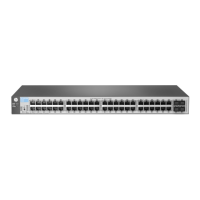1-6
Switch Overview
Switch Hardware Features
■ IEEE 802.3ab Auto MDI /MDI-X on all twisted-pair ports, meaning that all
connections can be made using straight-through twisted-pair cables.
Cross-over cables are not required, although they will also work. The pin
operation of each port is automatically adjusted for the attached device:
if the switch detects that a 10/100/1000 Mbps switch or hub is connected
to the port, it configures the port as MDI; if the switch detects that a 10/
100/1000 Mbps end-node device is connected to the port, it configures the
port as MDI-X.
■ an LED Power Down option that keeps LEDs turned off except for when
the Mode Select button is pressed, and an Auto Port Power Down option
that conserves power on a per-port basis by placing RJ-45 ports into a
lower power state when no link partner is detected.
■ automatic learning of the network addresses in each switch’s 16,000-
address forwarding table.
■ automatically negotiated full-duplex operation for all 10/100/1000Base-T
RJ-45 ports when connected to other auto-negotiating devices
■ easy management of the switch through several available interfaces:
• Web browser interface — an easy to use built-in graphical interface
that can be accessed from common Web browsers.
• ProCurve Manager (PCM) — allows network administrators to
discover and map the HP V1810-48G Switch within their network and
launch the switch’s built-in graphical interface from within PCM to
configure the switch.
■ support for up to 64 IEEE 802.1Q-compliant VLANs so you can divide the
attached end nodes into logical groupings that fit your business needs.
■ support for up to 16 trunks so you can assign physical links to one logical
link (trunk) that functions as a single, higher-speed link providing
dramatically increased bandwidth.
■ support for many advanced features to enhance network performance—
for a description, see the Management and Configuration Guide.
■ download of new switch software for product bug fixes.

